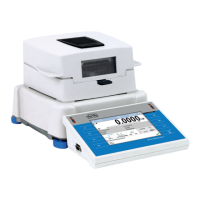17.2. SELECTION OF DRYING PARAMETERS
17.2.1. Selecting optimum sample mass
Sample mass influences the accuracy of measurement result and
measurement time. Higher mass of a sample, causes higher amount of water
(moisture content) which needs to evaporate, and therefore measurement
time is also longer.
Obtaining short measurement time is feasible in case of small sample mass,
but sample mass cannot be too small, as it may negatively influence required
measurement accuracy.
17.2.2. Influence of sample mass on measurement result repeatability
Sample mass considerably influences repeatability of measurement results
obtained on a moisture analyzer. Relation between sample mass and
repeatability is presented below.
The above data refers to a model, uniform sample, containing no moisture due
to the evaporation process and showing no signs of decomposition (e.g. wet
high-silica sand).
The results uncertainty cannot be avoided, this is due to sample nature and
moisture analyzer repeatability. In practice, it means that obtained
measurement result may exceed repeatability values provided above.
17.2.3. Drying temperature
Drying temperature has the largest impact on drying time. Temperature value
depends on type of dried substance. Too low drying temperature causes too

